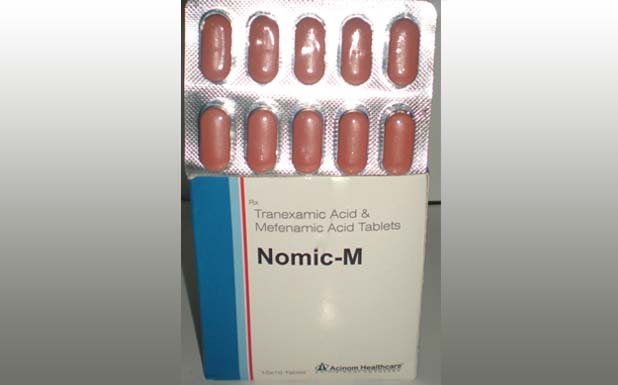Mefenamic acid is a non-steroidal anti-inflammatory drug used to treat pain, including menstrual pain. It is typically prescribed for oral administration.
Mefenamic acid decreases inflammation (swelling) and uterine contractions by a still unknown mechanism. However it is thought to be related to the inhibition of prostaglandin synthesis. There is also evidence that supports the use of mefenamic acid for perimenstrual migraine headacheprophylaxis, with treatment starting 2 days prior to the onset of flow or 1 day prior to the expected onset of the headache and continuing for the duration of menstruation. Since hepatic metabolism plays a significant role in mefenamic acid elimination, patients with known liver deficiency may be prescribed lower doses.Kidney deficiency may also cause accumulation of the drug and its metabolites in the excretory system. Therefore patients suffering from renal conditions should not be prescribed mefenamic acid.
Indications and Usage:
Mild to moderate pain, Rheumatoid arthritis, Dental pain, Postoperative pain, Dysmenorrhoea, Osteoarthritis, Menorrhagia
Pharmacology:
Tranexamic acid (AMCA) is a potent antifibrinolytic drug occurring in two isomeric forms; the antifibrinolytic potency resides in the transisomeric form. The main action of AMCA is blocking of the lysine-binding sites of the plasminogen molecule, which are of importance for the binding to fibrin. This prevents activation of plasminogen by plasminogen activator also absorbed to fibrin. AMCA can be administered perorally or intravenously and is excreted into the urine. It enters tissues and fluids in various concentrations and crosses the placenta. There is no evidence of a thrombogenic effect of AMCA, but in accordance with its action, it prolongs dissolution of fibrin deposits already formed. AMCA is a drug of high clinical value for the treatment of bleedings due to both systemic and local fibrinolysis Ponstel (mefenamic acid) is a non-steroidal anti-inflammatory drug (NSAID) that exhibits anti-inflammatory, analgesic, and antipyretic activities in animal models.
Pharmacokinetic:
| Mefenemic Acid | Tranexamic Acid | |
| Bioavailability | 90% | 34% |
| Excretion | Renal and fecal | Urinary |
| Half life | 2 hours | 3.1 hours |
| Metabolism | Hepatic (CYP2C9) | Hepatic (CYP2C9) |
| Protein binding | 90% | 90% |
Pharmacodynamics:
This is a non-steroidal anti-inflammatory drug (NSAID) that exhibits anti-inflammatory, analgesic, and antipyretic activities in animal models. The mechanism of action of mefenamic acid, like that of other NSAIDs, is not completely understood but may be related to prostaglandin synthetase inhibition
Drug Interaction:
Mefenamic acid enhances acitivity of oral anticoagulants but rarely significant. Increases risk of GI irritation with alcohol. Tranexamic acid has increased risk of thrombus formation with oestrogens.
● Contraindicated in pregnancy.
● Contraindicated in lactation.
● Contraindicated in children.
Contraindication:
Mefenamic acid is contraindicated in patients with active ulceration or chronic inflammation of either the upper or lower gastrointestinal tract. It should not be used in patients with preexisting renal disease.
Storage:
Store in the original package in order to protect from moisture.
